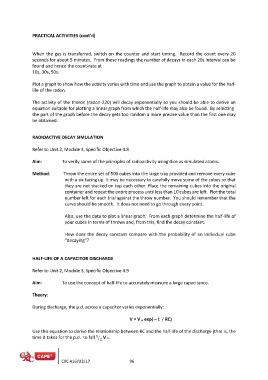Page 596 - SUBSEC October 2017_Neat
P. 596
PRACTICAL ACTIVITIES (cont’d)
When the gas is transferred, switch on the counter and start timing. Record the count every 20
seconds for about 5 minutes. From these readings the number of decays in each 20s interval can be
found and hence the count-rate at
10s, 30s, 50s.
Plot a graph to show how the activity varies with time and use the graph to obtain a value for the half-
life of the radon.
The activity of the thoron (radon-220) will decay exponentially so you should be able to derive an
equation suitable for plotting a linear graph from which the half-life may also be found. By selecting
the part of the graph before the decay gets too random a more precise value than the first one may
be obtained.
RADIOACTIVE DECAY SIMULATION
Refer to Unit 2, Module 3, Specific Objective 4.8
Aim: To verify some of the principles of radioactivity using dice as simulated atoms.
Method: Throw the entire set of 500 cubes into the large tray provided and remove every cube
with a six facing up. It may be necessary to carefully move some of the cubes so that
they are not stacked on top each other. Place the remaining cubes into the original
container and repeat the entire process until less than 10 cubes are left. Plot the total
number left for each trial against the throw number. You should remember that the
curve should be smooth. It does not need to go through every point.
Also, use the data to plot a linear graph. From each graph determine the half-life of
your cubes in terms of throws and, from this, find the decay constant.
How does the decay constant compare with the probability of an individual cube
“decaying”?
HALF-LIFE OF A CAPACITOR DISCHARGE
Refer to Unit 2, Module 3, Specific Objective 4.9
Aim: To use the concept of half-life to accurately measure a large capacitance.
Theory:
During discharge, the p.d. across a capacitor varies exponentially:
V = V o exp( – t / RC)
Use this equation to derive the relationship between RC and the half-life of the discharge (that is, the
1
time it takes for the p.d. to fall ⁄ V 0 .
2
CXC A16/U2/17 96

